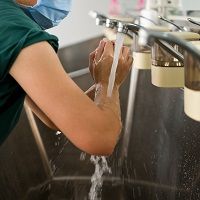Article
Hey Doctors, Wash Your Hands
Author(s):
The average healthcare professional cleans their hands less than half the amount that they should – a horrifying statistic on its own, but especially poignant on May 5, World Hand Hygiene Day.

The average healthcare professional cleans their hands less than half the amount that they should — a horrifying statistic on its own, but especially poignant on May 5, World Hand Hygiene Day.
In an ongoing effort to counteract that ratio, the Centers for Disease Control and Prevention (CDC) launched the “Clean Hands Count” campaign today.
“Patients depend on their medical team to help them get well, and the first step is making sure healthcare professionals aren’t exposing them to new infections,” CDC Director Tom Frieden, MD, MPH, said in a news release.
- Related: The Strange Way That Soap Can Lead to Obesity
The initiative has three main tiers to improve hygiene practices among healthcare professionals, but patients aren’t off the hook either:
- Improve healthcare provider adherence to CDC hand hygiene recommendations
- Address the myths and misperceptions about hand hygiene
- Empower patients to play a role in their care by asking or reminding healthcare providers to clean their hands.
A popular myth — emphasis on the “myth” – is that alcohol-based hand sanitizer does not contribute to antibiotic resistance. This is just the kind of education that the campaign is focusing on.
“We know that healthcare providers want the best for their patients, so we want to remind them that the simple step of cleaning their hands protects their patients,” said Arjun Srinivasan, MD, CDC’s associate director for healthcare-associated infection prevention programs.
The CDC reports that bout one out of 25 hospital patient acquires at least one healthcare-associated infection (HAI). Granted, infection rates have decreased in recent years: by 8% in hospital-onset Clostridium difficile (C. difficile), by 17% in surgical site infections in 10 specified procedures, and by 50% in central line-associated bloodstream infections (50%).
So for the sake of physicians and patients alike — let’s all wash our hands.
Also on MD Magazine >>> Let’s Get Smart About Antibiotic Prescribing





